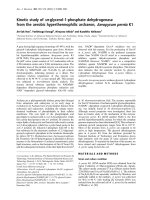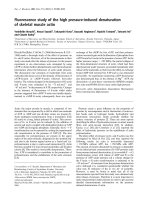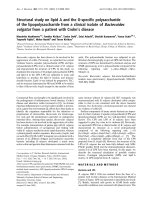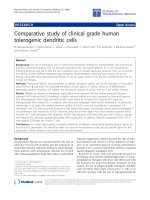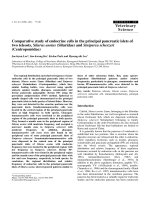Báo cáo y học: "Comparative study of serum Na+ and K+ levels in senile cataract patients and normal individuals"
Bạn đang xem bản rút gọn của tài liệu. Xem và tải ngay bản đầy đủ của tài liệu tại đây (71.79 KB, 5 trang )
Int. J. Med. Sci. 2004 1(3): 165-169
165
International Journal of Medical Sciences
ISSN 1449-1907 www.medsci.org 2004 1(3): 165-169
©2004 Ivyspring International Publisher. All rights reserved
Comparative study of serum Na
+
and K
+
levels in senile
cataract patients and normal individuals
Short research
paper
Received: 2004.5.18
Accepted: 2004.7.20
Published: 2004.8.05
Mansour Mirsamadi
1
, Issa Nourmohammadi
2
, Manuchehr Imamian
2
1
Department of Ophthalmology, School of Medicine, Iran University of Medical Sciences,
Tehran, Iran
2
Department of Biochemistry and Nutrition, School of Medicine, Iran University of Medical
Sciences, Tehran, Iran
A
A
b
b
s
s
t
t
r
r
a
a
c
c
t
t
Many factors such as aging, changes in blood electrolytes levels, and possibly
family history are involved in senile cataract formation. Changes in serum
electrolytes levels can induce changes in aqueous electrolytes levels and effect
on lens metabolism and probably cataract formation. In this paper, we study
serum level of Na
+
and K
+
in senile cataract patients and normal individuals.
Methods and materials: 155 senile cataract patients scheduled for cataract
surgery in eye clinic of Rasoul hospital and 155 normal individuals were
selected. Serum Na
+
and K
+
levels were measured by Flame Photometry
technique and means compared between two groups by t-test. Results: 1.
Mean serum Na
+
level in senile cataract patients and normal individuals was
144.96 ± 6.04 mEq/lit and 140.88 ± 2.27 mEq/lit respectively, and there was
statistically significant difference (P<0.0001). 2. Mean serum K
+
level in
senile cataract patients and normal individuals was 4.20 ± 0.34 mEq/lit and
4.15 ± 0.32 mEq/lit respectively, and there was no statistically significant
difference. Conclusion: Serum Na
+
level in senile cataract patients was higher
than normal individuals in this study. This result might suggest that diets
with high Na
+
content are a risk factor for age-related cataract formation, as
high Na
+
content of the diet leads to high level of serum Na
+
, which in turn
contributes to formation of age-related cataract.
K
K
e
e
y
y
w
w
o
o
r
r
d
d
s
s
Senile cataract, Na
+
, K
+
A
A
u
u
t
t
h
h
o
o
r
r
b
b
i
i
o
o
g
g
r
r
a
a
p
p
h
h
y
y
Mansour Mirsamadi obtained MD degree from University of Tehran in 1978, and then
studied ophthalmology for three years in Iran University of Medical Sciences. He is currently
an associate professor in Department of Ophthalmology, Iran University of Medical Sciences,
with research interests in epidemiology in ophthalmology.
Issa Nourmohammadi obtained BSc (Chemistry) from Langston University, Oklahoma, in
1976, MSc (Biochemistry) from University of Oklahoma in 1978, and PhD (Nutritional
Biochemistry) from University of Arizona in 1981. He is currently an associate professor in
Department of Biochemistry and Nutrition in Iran University of Medical Sciences. He is
interested in study of nutrition and trace elements in human blood.
Manuchehr Imamian obtained BSc in Chemistry from Payam-Nour University of IRAN in
1996 and MSc in Biochemistry from Iran University of Medical Sciences in 2001. His areas
of research focus on nutrition field.
C
C
o
o
r
r
r
r
e
e
s
s
p
p
o
o
n
n
d
d
i
i
n
n
g
g
a
a
d
d
d
d
r
r
e
e
s
s
s
s
Mansour Mirsamadi, MD, P.O. Box 14455-397, Niayesh St. Satarkhan Ave., Tehran 14455
Iran. Tel: ++ 98 21) 6504001-5, 6505001-9. Fax: ++ 9821) 6506864. E-mail:
Int. J. Med. Sci. 2004 1(3): 165-169
166
1. Introduction
One of the often seen consequences of the aging process is the development of senile cataract, a
disease that affects one of our most precious gifts, that of sight. This so-called senile cataract usually
occurs in those over 45 years of age. Approximately 75 percent of population over 75 suffer from lens
opacity or cataract, which is the major cause of poor vision and blindness in the world [1,2,3,4]. The
commonest form of cataract that is mainly found in ages more than 45 is named age-related or senile
cataract [3]. It should be mentioned that cataract surgery is the commonest case of surgery in the field
of ophthalmology [5].
Up to 50 millions in the world suffer from age-related cataract [6-7] and its prevalence in
developing countries is much more than the developed ones [8]. Annual new cases of cataract in India
is 4 millions [7], and more than one million cataract surgeries are done annually in United States of
America, although the accurate number of those suffering from cataract might be unknown [5]. In Iran,
there is no exact data for annual cataract surgery, but it seems to be more than 100000. Much cost is
spent on cataract surgery each year to prevent disabilities and improve quality of life, making it difficult
for the health system to carry on [5,9,10].
For the importance of cataract, research for clarifying its etiology is a necessity, so that many
future disabilities can be prevented, surgical costs reduced and quality of life improved. Multiple
mechanisms such as osmotic graduation [11,12], protein aggregates [13,14] oxidative stress [15,16],
post translational protein changes [17, 18, 19, 20, 21, 22], phase separation [3,11,24] are proposed for
cataract formation, though the exact pathogenesis is not known yet. Combined factors of heritage, UV
light exposure, diet, some metabolic disorders, quality of life, cationic pump malfunction and lens
metabolism disorder are believed to have a role in cataract formation [2, 25].
Since the lens metabolism is associated with aqueous humor [26, 27] and this thin fluid itself is
produced from blood secretions, serum electrolytes concentration directly affects electrolytes of
aqueous humor and in turn lens metabolism [2]. Biochemical studies have shown significant difference
(meaningful) in some serum electrolytes concentration in those suffering from age related cataract
versus those not [2,25].
In literature review no article was found about serum Na
+
level in senile cataract patients, but
particular consideration has been given by many researchers to the underlying role of nutritional status
in the process of cataract formation and the possibility that biochemical parameters can be used as
markers to determine the risk involved for cataractogenesis, considering the fact that it is possible to
modify these factors [5,7].
In a study in Iranian population – present study – plasma level of Na
+
, K
+
in age-related cataract
cases has been compared with an Iranian control group, without cataract.
2. Methods & Material:
Patients diagnosed as age-related cataract in ophthalmology ward of hazrat Rasool hospital,
Tehran, Iran hospitalized or in operation waiting list were selected as the case geroup. The control ones
were mainly selected from the close relatives of the patients. Both groups were investigated for any
drug intake, hypertension and any other systemic disease. Then positive ones of both groups were
excluded from the study.
Case and control groups were both examined by an expert ophthalmologist and routine ophthalmic
examinations including visual acuity determination, slit lamp examination, ophthalmoloscopy and
intraocular pressure measurement were done for all of them.
Patients suffering from age-related cataract with any other ophthalmologic disease or any past
history of ophthalmic surgery were excluded from the study. This exclusion criteria was also true for
the control group. Then a fasting-state blood sample was obtained from both case & control group and
sent to the laboratory. Serum Na
+
, K
+
levels were measured with flam photometry method by the aid of
SEAC model FLP20, Italy. Outcoming data was assessed by spss 11 software and mean of
aboveelectrolytes in both groups were compared by t-test.
3. Results
Int. J. Med. Sci. 2004 1(3): 165-169
167
In this study the case group consisted of 155 patients suffering from age-related or senile cataract
(79 female, 76 male) and the control one consisted of 155 of cases’ close relatives (79 female, 76
male). Mean age and standard deviation of patients and control group were 61.96±14.5, 59.63±13.8,
respectively. Age range of patients and controls were 44-85 year and 43-86 year respectively.
Table 1 shows serum Na
+
, K
+
of case and control groups, with a significant difference in serum
Na
+
of case and control ones.
Table 1. Comparison of Mean & SD of serum Na
+
, K
+
in 155 patients with cataract and 155 without
cataract.
Study group Serum
cations
Age-related cataract patients Control group P-value
Na
+
mean (mEq/lit) 144.96±6.04 140.88±2.27 <0.0001
K
+
mean (mEq/lit) 4.20±0.34 4.15±0.32 0.200
According to Table 1 serum Na
+
level in age-related cataract cases was more versus non-cataract
ones (control group). This table notifies meaningful difference of serum Na
+
level between two groups.
4. Discussion
The most important result of this study is elevated serum Na
+
level in those suffering from senile
cataract which verifies previous studies [2, 25, 28]. Though aging by itself is the most important risk
factor for cataract formation, other factors such as cataract family history, some biochemical elements
alterations in blood, may be the intervening ones [29]. Multiple studies have been done to clarify the
relationship between human biochemical elements and cataract formation.
Interestingly in some of these studies relationship between some serum biochemical elements
(such as Na
+
) and cataract have been verified [2,25,28]. In spite of this, in other studies, such as the
Italian – American cataract study [30], no relation between blood biochemical elements and cataract has
been shown. This contrast may be due to nutrition quality and different diets in nations all over the
world [31,32,33].
One of the proposed risk factors for cataract formation is serum Na
+
level [34,35]. Lens has high
content of potassium and low content of sodium. Lens K
+
level is 125 mmol/kg of lens water and lens
Na
+
is 14-26 mmol/kg of lens water [36]. These two cations are in balance with each other, which is
mainly due to Na
+
-k
+
ATP-ase pump and lens membrane permeability. Alteration in either of these ions
leads to cation imbalance in lens which in turn results in cataract formation [36]. Hence alteration in
cation concentration of aqueous humor which is attributed to alterations in serum cation concentration,
can be known as a risk factor for cataract formation.
Na
+
pump activity in lens is as in other cells and it is related to intracellular Na
+
, extracellular K
+
and eventually to serum concentrations of these ions [37,38]. Clayton et al [35,39] & Philips et al [37]
studies notify significant and meaningful difference between serum Na
+
of those suffering from age-
related cataract versus those not. It should be mentioned that, this is not true about K
+
in their studies.
In the present study of Iranian population the mean of serum Na
+
in age-related or senile cataract
cases was 144.6 ± 6.04 versus 140.88 ± 2.27 of the control group, which declares meaningful difference
(P<0.0001). Though the mean of serum Na
+
of the patients were in the Na
+
normal range but it was in
the upper limit of this range (135-150 mEq/Lit) and in comparison with control group, the serum Na
+
of
the patients was elevated, which notifies significant difference. Results of the present study in Iranian
population is in favor of studies such as Clayton et al [35,39], Philips et al [37] and Shoepheld-ER et al
[31].
At last, it seems that diets with high Na
+
content are a risk factor for age-related cataract formation.
As it seems, high Na
+
content of the diet leads to high level of serum Na
+
, which in turn contributes to
formation of age-related cataract [31, 32, 33]. Eventually, further studies in certain regions of the world
in age-related catarct cases with certain diets is suggested. In this order, results can be compared with
similar studies.
Conflict of interest
The authors have declared that no conflict of interest exists.
Int. J. Med. Sci. 2004 1(3): 165-169
168
References
1. West SK, Valmadrid CT. Epidemiology of risk factors for age-related cataract. Survey of Ophthalmology
1995; 39: 323-327.
2. Van Heyningaen R. The Lens: Metabolism and cataract. In: Davson H, ed. The Eye. New York: Academic
Press, 1961:380-488.
3. Donnelly CA. Some plasma constituents correlate with human cataract location and nuclear colour.
Ophthalmic Research. 1997; 26: 207-21.
4. Kuszak JR. Embryology and anatomy of the lens. In: Tasman W, Jaeger A, eds. Duane’s Clinical
Ophthalmology. Philadelphia: Lippincott - Raven publishers, 2000:2-8.
5. Sperduto RD. Epidemiological aspects of age-related cataract. In: Tasman W, Jaeger A, eds. Duane’s
Clinical Ophthalmology. Philadelphia: Lippincott-Raven publishers, 2000:3-11.
6. Bunce GE, Kinoshita J, Horwitz J. Nutritional factors in cataract. Annual Review of Nutrition, 1990;10:233-
54.
7. Minassian DC, Mehra V. Blinded by cataract: Each year projection from the first epidemiological study of
incidence of cataract blindness in India. British Journal of Ophthalmology. 1990; 74:341-343.
8. Sperduto RD. Epidemiological aspects of age related cataract. In: Tasman W, Jaeger A, eds. Duane’s
Clinical Ophthalmology. Philadelphia: Lippincott-Raven publishers, 2000:12-14.
9. Kahn HA, et al. The Framingham eye study I. Outline and major prevalence findings. American Journal of
Epidemiology, 1977; 106: 17-32.
10. Jacques PF, Chylack LT, McGandy RB, et al. Antioxidant status in persons with and without senile cataract.
Archives of Ophthalmology 1988; 106:337-343.
11. Duncan G, Bushell AR. Ion analysis of human cataractous lens. Experimental Eye Research, 1995; 20: 223-
30.
12. Duncan G, Bushell AR. Relationships between colour, Na
+
, protein content in individual senile human
cataract lens. Ophthalmic Research. 1980; 11: 379-83.
13. Kupfer C. The conquest of cataract: A global challenge. Trans Ophthalmology Society. 1984; 104:1-10.
14. Diplock AT, et al. Function of food science and defence against reactive oxidative species. British Journal
of Nutrition, 1998; 80: 7-12.
15. Machlin LJ, Bendich A. Free radical tissue damage: Protective role of antioxidant nutrients. Journal of
Federation of American Societies For Experimental Biology, 1987; 9:444-445.
16. Jacob RA, Buri BJ. Oxidative damage and defence. American Journal of Clinical Nutrition. 1996; 63: 985-
990.
17. Claytone RM, Culthbert J, et al. Some risk factor associated with cataract in Scotland. A pilot study. Trans
Ophthalmology Society, 1982; 102: 331-36.
18. Borekhuyse RM. Biochemistry of membranes. In: Duncan G, ed. Mechanisms of cataract formation in
human lens. London: Academic Press, 1981:36-45.
19. Alcala J, Maisel H. Specific antiserum to the main intrinsic polypeptide of lens fiber cell plasma membranes.
Experimental Eye Research, 1978; 26:219-21.
20. Kinoshita JH. Selected topics in ophthalmic biochemistry. Achieves of Ophthalmology, 1964:542-554.
21. Spector A. The search for a solution to senile cataract. Investigative Ophthalmology & Visual science, 1965;
96: 244-248.
22. Augusteyn RC. Protein modification in cataract: Possible oxidative mechanisms. In: Duncan G, ed.
Mechanisms of cataract formation in the human lens. London: Academic press, 1981:107-115.
23. Bolemendal H. Molecular and cellular biology of the lens. New York: John Willey and Sons. 1981.
24. Benedek GB. Theory of transparency of the eye. Ophthalmology, 1971; 10: 459-73.
25. Donnelly CA, Seth J, et al. Some blood plasma constituents correlate with human cataract. British Journal of
Ophthalmology 1995; 79: 1036-1041.
26. Luntz MH. Clinical types of cataract. In: Tasman W, Jeager A, eds. Duane’s Clinical Ophthalmology.
Philadelphia: Lippincott-Raven publishers, 2000:5-7.
27. Daliles MB, Kinsohita JH. Pathogenesis of cataract. In: Tasman W, Jeager A, eds. Duane’s. Clinical
Ophthalmology. Philadelphia: Lippincott-Raven Publishers, 1995:2-5.
28. Nourmohammadi I, Gohari L, Modarres M, Ghayoumi A. Evaluation of erythrocyte glutathion peroxidase,
superoxide dismutase and total antioxidants in cataract patients. Archives of Iranian Medicine, 2001; 4: 123-
127.
29. Leske MC, Chylack LT, Wus Y. The lens opacities case-control study. Archives of Ophthalmology, 1991;
109: 244-248.
30. The Italian-American Cataract Study Group. Risk factors for age-related cortical, nuclear and posterior
subcapsular cataracts. American Journal of Epidemiology, 1991; 133: 541-44.
Int. J. Med. Sci. 2004 1(3): 165-169
169
31. Shoenfeld ER, et al. Recent epidemiologic studies on nutrition and cataract in India, Italy and the United
States. Journal of American College of Nutrition. 1993; 12: 521-6.
32. Barber CW. Free amino acids in senile cataractous lenses: possible osmotic etiology. Investigative
Ophthalmology. 1963;7:564-567.
33. Phillips CI, et al. Cataract: A search for associated or causative factors. Excerpta Medica 1980: 19-25.
34. Sperduto R, Hiller R. The prevalence of nuclear, cortical and posterior sub-capsular lens opacities in a
general population sample. Ophthalmology, 1984, 91: 815-818.
35. Clayton RM, Cuthbert J, Phillips CI, Bartholomew RS, Stokoe NL, Fytch T, et al. Analysis of individual
cataract patients and their lenses: A progress report. Experimental Eye Research. 1980; 31: 533-536.
36. Delamere NA, Paterson CA. Crystalline lens. In: Tasman W, Jeager A, eds. Duane’s Foundations of Clinical
Ophthalmology. Philadelphia: Lippincott-Raven Publishers, 2001: 5-11.
37. Phillips CI, Bartholomew RS, Clayton R, Duffy J, et al. Cataract: A search for associations or causative
factors. In: Regnault F, ed. Symposium on the Lens. Princeton, NJ: Excerpta Medica. 1980:19-25.
38. Raven J. Physiology of the lens. In: Tasman W, Jeager A, eds. Duane’s Clinical Ophthalmology.
Philadelphia: Lippincott-Raven Publisher, 2001: 2-9.
39. Clayton RM, et al. Some risk factors associated with cataract in Scotland: A pilot study. Trans
Ophthalmology Society, 1982; 102: 331-6.


